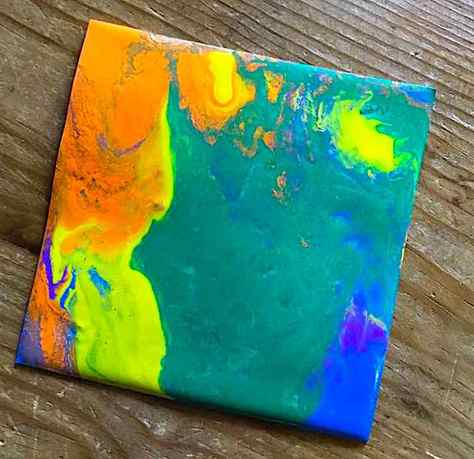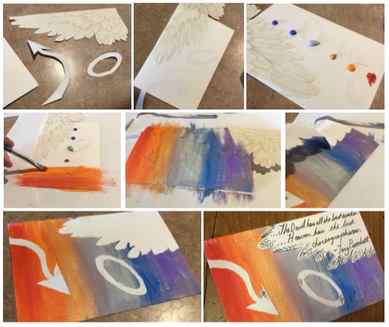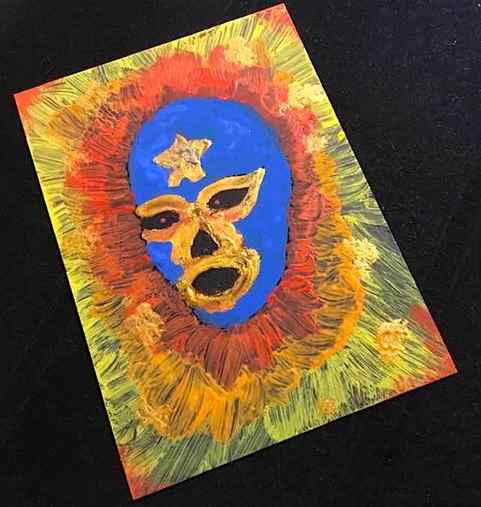Increasing the changes in color, value, and even the sizes and placement of forms can help give small paintings a more expansive feel. My 12” x 24” painting Early Morning at Caprock Canyon puts a darker, cooler foreground against a brightly lit background.
Think Big. . . 4 Huge Tips for Painting on Small Canvases
As artists, we often obsess about the many and varied elements of our work. Everything from subject matter to color theory and paint handling come under close scrutiny.
But there’s one aspect that many of us often overlook: size.
Small, medium, or large, the dimensions we choose for our artwork will always have a tremendous impact on the effect it has on viewers.
As a young artist in college I was obsessed with large drawings and paintings. I rarely worked on anything smaller than three feet, and many of my paintings were six foot or more in size. Like much of the art world I believed that “bigger is better.” I equated size to quality, personal expression, and impact.
Over the years much has changed about my art making process. I’ve come to re-evaluate the “bigger is better” myth. In the process, my work has shrunk in physical size, but expanded in so many other ways. I’ve also come up with a few tips that I hope will help other artists work smaller as well. Here are some of the insights I’ve gained:
Suggest detail instead of illustrating it in full
Consider using large blocks of solid colors. Using large shapes and loose handling can help keep you from feeling “boxed in” or cramped in the smaller format. My painting The Rocky Shore contains very little in the way of details yet comes across as a realistic view of Lake Mineral Wells.

The foliage is rendered in two or three large masses of color. The ripples of the waves are freely handled brushstrokes. I don’t try to indicate a leaf or a blade of grass. There’s really very little need to. Our vision is not merely a function of our eyes. When we view something our mind acts as a filter, interpolating and extracting much than our eyes can see.
Keep thinking big – deep, wide, and far
Just because the canvas is small doesn’t mean that the sense of scale and depth have to be small. I often use strong diagonals and foreground elements to create an larger sense of space.

Frosted Field, above, is just 8″ x 10″ but it uses converging diagonals of a snow-covered plowed field to direct the viewer’s eye to a distant tree line, giving a sense of depth that isn’t constrained at all by the size of the painting.
And it can work with offset angles, too. I added depth to my small painting Along the Beach with a strong diagonal of sea oats in the extreme foreground.

A bit of aerial perspective, or the gradual shift in colors from warm to cool as they recede in space will also help to give an otherwise small scale painting a huge feeling of space and atmosphere.
Mini Paint Pouring (Fluid Art)

There have been several art demos for paint pouring on YouTube lately, with some artists doing colorful, fun effects on big canvases. Unfortunately, this can take a bunch of paint and space, and be pretty messy. This is something that parents don’t always have the time to do when working with smaller kids.
Bring this down do little images no larger than 4″ X 4″ and it can still be fun.
Cut some cardboard into small squares for your canvas, and place them on the center of a paper plate. Tack it down with a little piece of tape, to hold it in place.
Get out a small paper or plastic cup for each color you want, and pour a little of the acrylic paint in it. When you see most paint pouring, they are using some type pouring medium to help the paint flow. When dealing with a small enough surfaces, Mod Podge or plain school glue with a drop of water can be used in place. Pour a little in each cup and mix the paint and glue with toothpick. I used about mix of two parts paint and one part glue.
Now, let kids use their imagination and play with different pouring techniques. They can pour big drizzle areas over the top, our pour small ripple puddle by continuing to pour one color slowly on top of the other.

To help these colors cover the whole canvas, pick up the entire plate and tilt it around. The small size and rims of the plate help keep the mess factor down. Let it dry completely. This may take overnight, so be patient.
This method will probably make the heads spin of more seasoned artists, but it works just fine for kids and hobbyists.
The Cutout “Silhouette” Postcard prints

I found “half-size” prints to be more desirable than 8″ X 10″ or larger, and when kids are painting on a piece of drawing paper or cardstock, you can double the amount of paintings you can do.
To make a “silhouette” either find and cut out a shape or picture from a magazine or draw your own. Younger artists might want to use easy geometric shapes like triangles or circles. Use a school glue stick lightly to tack in on the paper where you want. Make sure the edges are all secure, so paint can’t ooze under it.

Don’t use too much glue, or this will be hard to peel off the paper. If you have a little canvas square, this will be even easier to peel, but it is often easier and cheaper to find thick paper like cardstock or watercolor paper.
Dab a few different small color dots of paint in a line down the paper from top to bottom. Use one brush and start at the top, them paint slowly from side to side going down the paper a little more each time.
This will blend the colors on the paper, and will cover the cut out completely. Peel off the cut out to reveal the silhouette.
Leave it as it is, or use a thin paintbrush or maker to draw some details in the “blank space.”
Trading Card Makeovers

The fun trading card makeover will create a completely different design on an everyday picture.
This process is similar to two ideas I have used in the past: the “alien product” idea like those seen at Meow Wolf: House of Eternal Return, and the “upcycled Christmas card college.” Take something plain, and make it weird and new.

Find an old trading card (one that isn’t of any sentimental or monetary value, preferably). One reason I chose trading cards is unlike pictures from a paper or magazine, they are already a nice, uniform shape, and are thick enough not to bubble up or warp when painted.
Using thin brushes and plain acrylic paint, use the photo or drawing on it as a template for creating a new painting. For example, take a picture of a “regular person” and make them monster, alien or superhero. I like finding plain portraits, because they make perfect templates for practicing facial shapes and features. It is also fun to find a classic cartoon image and turn it into something new.
It is that simple.

This is a fun way to use those trading cards that clutter drawers and boxes, and create little original pieces of art they can use for one-of-a-kind decorations or gifts.
Master Yoda once demonstrated the power of The Force by proving “size matters not.” The same holds true with these little drawings. Even when the surface is small, they can still hold some very big, imaginative ideas.
What is a mini canvas art?

A mini canvas art is small enough to fit in the palm of your hand.
Mini canvas art contains a small world that the artist make on a mini-sized canvas.
Because of their small size, if you display mini canvas arts of colorful or playful artwork, they fit in with the interior.
The good thing about a mini canvas art is that even works with a strong presence do not make too strong an assertion when you display it in your home.
It is fun to choose your favorite artwork and display it in a playful way.
How to display a mini canvas art

Because of their small size, you should display mini canvas arts on furniture such as a cabinet, bookshelf, desk, storage furniture, or side table.
Hanging it on a wall in a small space such as an entryway or bathroom will make the interior balance nicely.
Let’s take a closer look at how to display a mini canvas art.
(1) How to display it above the console table in an entryway

Hanging a mini canvas art on the wall above the console table in the entryway will make the entryway look very stylish.
You can also display the canvas standing up above the shelf in the entryway.
You can also arrange sundries, flowers, and houseplants together with the mini canvas art.
When decorating a mini canvas art and sundries side by side, choose sundries that match the mini canvas painting to create a sophisticated impression.
If you would like to know more detailed information on how to decorate a painting in an entryway, please see the article, “Entryway Wall Art Decorate Ideas for Bright Impression“.
(2) How to Display it in a bathroom

You can hang a mini canvas art on the walls of your bathroom to accentuate the space.
Hanging it on the wall near the mirror in the bathroom or next to the toilet seat will neatly organize the interior space and make it easier to view the painting.
The key is to hang it in a place where you can easily see it when you spend time there.
In the photo above, a miniature canvas art in a fresh color scheme of white, light blue, and brown is displayed on a white wall in the bathroom.
Displaying with brightly colored artwork is best as it brightens up the washroom space and makes it more comfortable.
Since bathrooms are simple spaces, displaying them with art can make a big difference in the ambience of the room.
The following article explains how to decorate a wall art in the bathroom. Please take a look here as well.
(3) How to Display it above a desk in a study

It is good to display mini canvas arts on the wall above the desk in the study.
When you hang a mini canvas art in your study, hang it in a place where you can easily view it when you are sitting at your desk.
If you hang it on the wall above your desk in the study, you can look at it when you change your mind.
Looking at your favorite work of art when you want to change your mind will brighten your mood.
Looking at a painting will make you feel refreshed and may even give you new ideas.
The photo above shows an study room with a mini canvas artwork displayed on the wall above a desk.
It is also stylish to display a mini canvas art in combination with other artwork or flowers.
To learn more about how to decorate a wall painting in your study, please visit the article, “3 Nice Wall Painting Decoration Ideas For Study Room“
How to hang a mini canvas art on the wall
Anyone can easily hang a mini canvas on the wall by preparing the necessary hardware for wall-hanging.
We show a simple explanation of how to hang a mini canvas on the wall in the article, “How To Hang A Oil Painting Canvas Without A Frame Easily“.
We also show you how to hang it without making a big hole in the wall and how to hang it on a concrete wall.
Also, when framing a mini canvas art, choose a frame that matches the impression of the artwork and the ambience of the room where you will display it.
The following is an easy-to-understand explanation of how to choose a frame for displaying a canvas art. Please take a look at this page as well.
Display small canvas paintings.
Mini canvases and other small paintings can make your home look stylish when you display it in a small space.
We have compiled the following article on how to decorate small canvas paintings.
If you want to know more about how to decorate small paintings, please refer to the article below as well.
Display your small space with a mini canvas art to make your home stylish.





